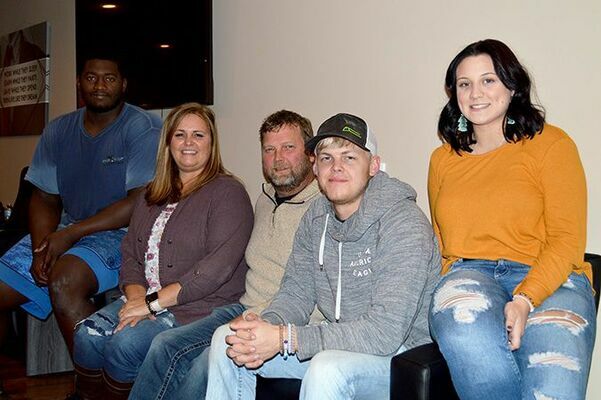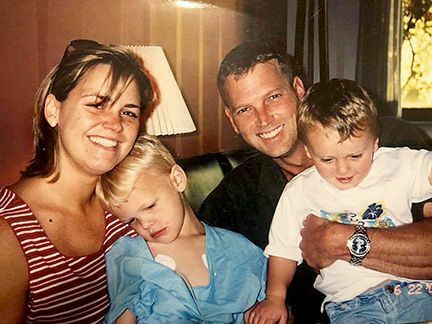Hodges family lives out Diabetes Awareness slogan
Greg and Terri Hodges of South Fulton agree, in thinking back to their first born’s toddler stage of life, realize now, back then there were signs.
“He was constantly thirsty,” Greg said, referring to now 20-year old Carter, who was diagnosed with Type 1 Diabetes at the age of three.
At that time, Greg and Terri were anticipating the birth of Sophia, and second son, Mason was a year old.
“I was on a work trip to New York, had been gone for maybe two days, when Terri called me,” Greg said.
“Carter was throwing up and we ended up in the E.R. We then went from there to the I.C.U., and his sugar was over 1200,” Terri said.
Carter admitted he didn’t remember much about the ambulance ride to LeBonheur Children’s Hospital. He did say he had some memories of always being thirsty, often even sucking on a water soaked wash cloth.
“We would find him at the sink, just filling his hands with water and drinking water that way,” Greg said.
Constant thirst, frequent urination, weight loss and frequent bouts of exhaustion were also signs the couple admit seem so apparent now, as to symptoms of Type 1 Diabetes. But as most parents can attest, toddlers may often loose weight as they become more active, from the crawling to walking, and running stage. Too, battles may take place at the dinner table, with attempts to convince an on-the-go little one the importance of eating.
“He didn’t care that much about eating but always wanted to drink,” Terri said.
Greg remembers in the E.R., the entire area smelled like fruit cereal.
“It smelled like Froot Loops. That’s another indication about Type 1, urine has a sweet, fruity smell,” he said, adding he nor Terri had any knowledge of Type 1 in their families.
The couple agrees initially they had a great doctor to help them adjust to the disease, which involves an autoimmune destruction of the insulin-producing beta cells in the pancreas.
“The doctor was very matter-of-fact, and that was good,” Greg said.
“We had to practice giving the insulin shots on an orange before we left the hospital,” Terri said.
“We were also advised not to become a short order cook, to let Carter eat what we ate, just cut back on carbs. Of course, noodles and bread were what he would want,” she said.
“It was scary, though, to come home. You just don’t sleep, wondering if his sugar is OK,” Terri added.
Living with the disease, as a family, has become an ongoing journey of awareness and education.
When Carter started school, a plan was put in place, by which Terri and Greg could outline the procedures to follow, in the event his sugar levels became high or low at school.
“The schools here were wonderful,” Terri said.
By that time, Carter had learned to recognize some of the “feelings” he would have to alert a variance in his sugar levels.
“I always had Skittles, in case I needed to eat them to get my levels where they needed to be. So, yea, I could eat the Skittles and not get in trouble,” Carter said.
He also admits there may have been times when a handful of the candy could have been consumed, as a preventative measure....just in case.
Carter’s siblings and friends have become educated on warning signs regarding his levels as well.
“Carter always snores. Always,” said Jalen Scott, Carter’s long-time “brother-friend”.
“There was one time when me, Blake and Mason Wells were spending the night, and I realized that Carter wasn’t snoring. I knew that meant something, and he was having a seizure. So that’s when I went and woke up his aunt, who was staying with us,” Jalen said.
He also remembered at a young age when he would come to play with Carter, if he suddenly seemed to become easily agitated, that signaled a sugar issue. Jalen has learned to recognize a glassy look to Carter’s eyes and dilated pupils as an indicator.
Carter’s younger brother, Mason, now 18, according to Terri, has a friend who is diabetic, and that friend’s mother feels comfortable in knowing Mason is around, when she isn’t, as he has become so familiar with telltale signs associated with diabetes, and knows how to respond.
Trinity Wright, who has been friends with Carter since third grade, and eventually became his girlfriend, said she has become more aware of the symptoms and warning signs.
“I will ask him a lot, have you checked your sugar?,” she said.
Younger sister Sophia, now 15, has also embraced her older brother’s diagnosis, educating herself at an early age about the disease, which makes up an estimated 5-10% of all cases of dibetes.
“You know, Carter can never just be having a bad day. It’s like any time we see a sign of him being anxious or irritable, we ask him if he has checked his sugar. It’s like sometimes, maybe he is just having a bad day,” Greg said.
Carter said he keeps a check on his sugar now, monitoring it three to four times a day.
The young man has not let his diabetes limit him. While he admits to sometimes “pushing through” to continue playing the sports he loves, he also recalls making every attempt to get to the locker room as quickly as possible to give himself an injection when necessary, before the other players come in. He has been giving himself injections since about the age of 10.
“You know, 17 years ago, we were told a cure was 10 years out,” Greg said.
While advances have been made, that cure has yet to be found.
Currently there are pumps, Omnipods, which are tubeless insulin pumps, watches with mechanisms on the back side to monitor sugar and even color changing tattoos which alert to low sugar.
“Right now, with me being so active, and playing sports, I tried the pump and the Omnipod, but with being active, and physical activity which can make you sweat, those things can come off. I just asked the doctor if I could just go back to not having something attached to my body,” Carter said, adding perhaps when he is older and not as physically active, he would consider those methods of regulating his sugar levels.
While the number of people affected globally is unknown, estimates show about 80,000 children developing the disease each year. If left untreated, diabetes may cause complications with a relatively rapid onset, including diabetic ketoacidosis and nonketotic hyperosmolar coma. Longterm complications include heart disease, stroke, kidney failure, foot ulcers and damage to the eyes.
For many years when their children were young, Greg and Terri Hodges participated in the JDRF Walk, facilitated by the nonprofit organization that funds type 1 diabetes research and advocates for regulation favorable to medical research to make it easier to market new medical devices.
The money raised through the Walk supports life changing breakthroughs and gives hope to those impacted by the disease.
This year’s logo for November’s designation as Diabetes Awareness Month includes three words, Educate. Advocate. Cure.
Two of those three words have become common to the Hodges family, as they continue to have hope for the third.
Please support The Current by subscribing today!
 Loading...
Loading...









.jpg)


